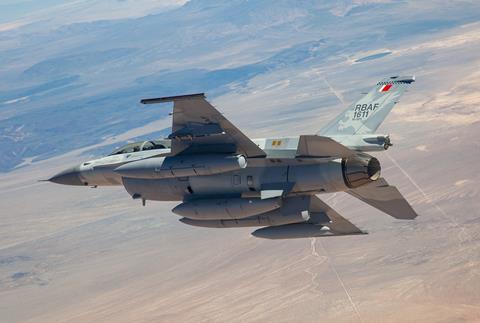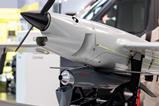L3Harris is anticipating the launch of a flight-test campaign involving its Viper Shield electronic warfare (EW) system – technology that will play a key role in protecting new Lockheed Martin F-16 fighters operated by nations including Bahrain.
The US company announced in early November that it had completed laboratory-based safety of flight qualification activities on Viper Shield, during which it “passed a series of environmental and electrical tests across structural integrity, thermal and electrical safety, and aircraft aerodynamics”.
Additionally, the system “handled the [simulated] stresses and strains of normal and extreme flight manoeuvres… and proved to be safe, reliable and effective”.

Flight trials are likely to commence before year-end at the US Air Force’s (USAF’s) Edwards AFB in California using a Block 70-standard F-16. The identity of the aircraft’s owner has not been disclosed, but two Royal Bahraini Air Force examples are currently located at the site.
An all-digital system using six line-replaceable units and a cockpit display, Viper Shield will enhance a pilot’s situational awareness, “and helps them identify, locate and counter threats to enable survivability and lethality in the most challenging environments”, L3Harris says. In use, the system “counters modern radar threats with immediate detection and advanced jamming responses”.
Crucially, the technology – which combines radar warning receiver and electronic countermeasures capabilities – can be installed without external modification to the F-16, and is fully integrated with the Block 70/72’s Northrop Grumman APG-83 active electronically scanned array radar.
L3Harris is on contract to provide Viper Shield to “six international partners”, as baseline equipment on 168 new F-16s. The latest version of the type is operational with or on order for the air forces of Bahrain, Bulgaria, Jordan, Morocco, Slovakia, and Taiwan.
The company expects to have a seventh customer confirmed “very soon”, with at least another two near-term prospects, says Travis Ruhl, director of international business development, electronic warfare, airborne combat systems. Such announcements are likely to involve the provision of Viper Shield to equip older-model, mid-life update-standard F-16s for an undisclosed nation, he indicates.
System deliveries are due to start late next year, with the technology to enter operational use in 2026. “Viper Shield is well along the development curve,” the former USAF F-16 pilot told FlightGlobal at the Bahrain International Airshow near Manama on 13 November.
The company notes that its system also has been designed “to allow for future capability upgrades, ensuring it can adjust to an evolving electromagnetic spectrum environment”.
With its EW offering, L3Harris looks set to benefit from Lockheed’s late order revival with the F-16: a type first flown in prototype form 50 years ago.
“People like the aircraft, and the capabilities it brings,” Ruhl says.
L3Harris is also currently working on a pod-housed version of the Viper Shield system. Separately, it is advancing development of a so-called Distributed Spectrum Collaborative Operations – or DISCO – capability which will enable operators to make and share near real-time updates to EW threat libraries to swiftly counter hostile action.
The DISCO technology has already been showcased during a Valiant Shield exercise conducted in the Pacific region.































